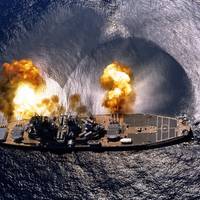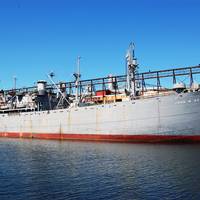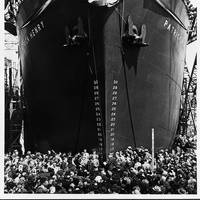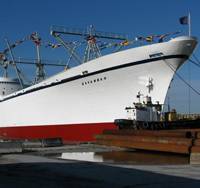Great Ships and The Ship Designer’s Curse

For the Design issue Greg Trauthwein asked me to write about a favorite ship design. I have no favorite ship design, or should say there are simply too many that are truly worthy of mention. But when considering favorite designs, ship designers (and builders) do carry a strange curse. Unique among engineers (and artists, architects, and industrial designers) their creations only live for about 30 years. With very few exceptions, in their own life time, ship designers get to see the disassembly of most of their creations. I am not aware of any other creations that are so readily tossed aside.
Grooving the Way: Back to the Future
Anything but new, the Victaulic method of pipe-joining has been around for a long time. Armed with myriad type approvals from most IACS groups, Victaulic’s output will no doubt (and soon) form a part of your marine equipment for a long time to come. The conservative and staid domestic waterfront, especially where it intersects boatbuilding and repair, recently set sail for increased efficiencies, driven in part by emerging technologies, but also through improved management and new assembly techniques. It was in 2013 that Boysie Bollinger’s son, Chris Bollinger, then a member of the Bollinger senior management team, proclaimed, “Boatbuilding is evolving into something that will more closely resemble manufacturing…
Grooving the Way: Back to the Future
Anything but new, the Victaulic method of pipe-joining has been around for a long time. Armed with myriad type approvals from most IACS groups, Victaulic’s output will no doubt (and soon) form a part of your marine equipment for a long time to come. The conservative and staid domestic waterfront, especially where it intersects boatbuilding and repair, recently set sail for increased efficiencies, driven in part by emerging technologies, but also through improved management and new assembly techniques. It was in 2013 that Boysie Bollinger’s son, Chris Bollinger, then a member of the Bollinger senior management team, proclaimed, “Boatbuilding is evolving into something that will more closely resemble manufacturing…
WW II Liberty Ship Leak-free after 70 Years

To address the sudden need for supplies overseas during World War II, the United States government launched the Emergency Shipbuilding Program in 1941 that resulted in the construction of more than 5,700 cargo ships for the U.S. Maritime Commission. 2,710 of these vessels were of a design that became known as Liberty ships. These vessels were designed as economically and quickly built cargo steamers that formed the backbone of a massive sealift of troops, arms, materiel and ordnance to every theater of the war. Two-thirds of all cargo that left the U.S.
Ugly Ducklings & Steaming the Way to Victory in WWII

The design and construction of WWII Liberty cargo ships revolutionized shipbuilding by overhauling the blueprint process and standardizing on commonality of parts, welding, pre-fabrication and assembly line construction. Give me Liberty, or give me death!” a rallying cry of the Revolutionary War, got a second act in World War II. “Built by the mile and chopped off by the yard,” Roosevelt promised the no-frills Liberties would form a “bridge of ships” across the Atlantic. And they did. An exaggeration perhaps, but in truth, the Liberty wasn’t much to write home about.
N.S. Savannah Celebrates 50th Anniversary

When the first nuclear-powered merchant ship N.S. Savannah was christened and launched on July 21, 1959, First Lady Mamie Eisenhower served as the sponsor. Plans are being made to replicate those events this year on Saturday and Sunday, July 18-19. The 50th anniversary events will occur at N.S. Savannah's layberth at Canton Marine Terminal Pier 13, Baltimore, Maryland. This will be the first time the 596-ft. ship will be open for general tours since she sailed from Patriots Point, Charleston, SC, in 1994.
MARAD’s Last Liberty Ship Reaches Greece
Flying the Greek flag, the Hellas Liberty, formerly known as the Arthur M. Huddell, has safely reached the port of Piraeus in Greece after leaving Norfolk, Virginia, on December 6, 2008. Until July 2008, the World War II-era Huddell was the last Liberty ship in the Maritime Administration’s National Defense Reserve Fleet., and was moored in the James River Reserve Fleet site at Fort Eustis. The ship was cleaned at a Norfolk shipyard before being towed to Greece. American shipyards built 2,751 Liberty ships during World War II, in the largest shipbuilding effort in history. Liberty ships crewed by merchant mariners carried troops and military cargo all over the world. The building and sailing of the Liberty ships, and their successors, the Victory ships, were overseen by the U.S.
Last Liberty Ship May Go To Greece
Maritime Administrator Sean T. Connaughton signed a Memorandum of Understanding with representatives of the Government of Greece to pursue an agreement to transfer the ship Arthur M. Huddell to the Greek government for use as a museum. The World War II-era Huddell is the last ship in the Maritime Administration’s fleet. It is currently moored in the James River Reserve Fleet site at . "It is great to be able to save a bit of history from both our nations," said Connaughton. American shipyards built 2,751 ships during World War II, in the largest shipbuilding effort in history. ships crewed by merchant mariners carried troops and military cargo all over the world. The building and sailing of the ships, and their successors, the Victory Ships, were overseen by the U.S.
New York's New Faces
How many vessels entered New York Harbor for the very first time in the past year or two? Oh, probably a million. And probably most of them kept going, up the North River, out the East River, up to beantown or clamtown in one direction, cheesetown in another. Stop for a snack in New York, it's Boar's Head 24x7. Forty-eight hours later, it's catfish. Near everything, there are a lot of good reasons to come to New York, and a lot of good reasons to leave. A lot of good reasons to stay too, sometimes. Quite a few new faces have done just that, making New York Harbor all the handsomer. We thought we'd look a few over. At least four of the boats are new builds, arriving since May 2003; the others are acquisitions to enlarge and upgrade their fleets' capabilities.
Diver Down!!! An Exception to the General Test for Seaman Status?
By James P. Nader & Joseph A. Once again we take that familiar voyage know as "determining seaman status." No matter how familiar the voyage there are always changes in the currents which guide your path. Seaman status is important because only a seaman may receive maintenance and cure, and pursue a claim for Jones Act negligence or unseaworthiness. The basic requirements for seaman status are well established in maritime law. In order to qualify as a seaman under the Jones Act, a person's employment duties must contribute to the mission of the vessel and be connected to an identifiable group of vessels in navigation. The United States Supreme Court has held that seaman status should be determined by the specific facts of each case.







